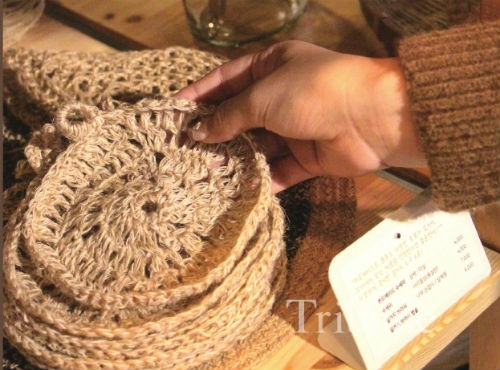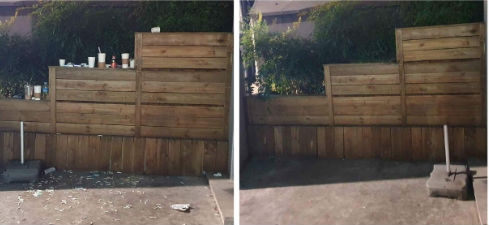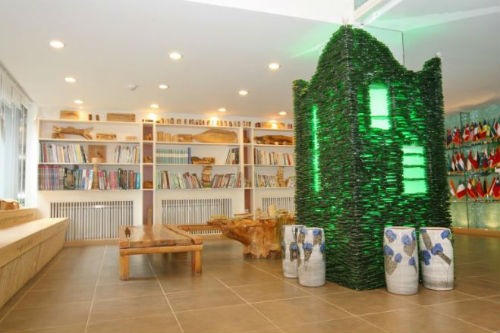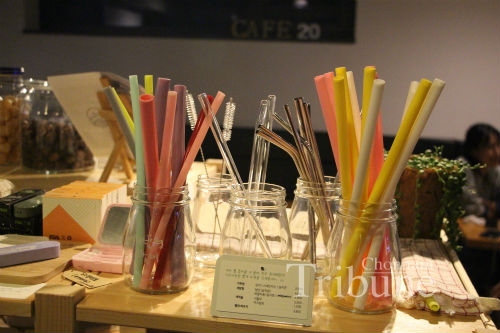
Under the influence of Corona-19, which started to spread early this year around the world, people have spent more time at home. The use of disposable products such as plastic containers from delivery food, parcels, masks, and sanitary gloves has increased, and the amount of trash generated here has also increased at the same time. According to the statistics from the Ministry of the Environment, the daily average amount of plastic waste generated in the first half of 2020 was increased by 15.6%, year-on-year and the amount of plastic waste generated by us increases by 11.1%. Such waste has caused various kinds of environmental pollution that is a huge threat to human health. Therefore, more and more people have expressed concern about the contaminated environment and participated in various environmental campaigns in their daily lives. The Chonnam Tribune listened to people who are trying to reduce trash and looked at their positive impact on the environment.

Exercising and Collecting Waste
What are simple ways we can reduce damage to the environment and live a sustainable life? Trash reduction may be the first thing that comes to mind, as a way to reduce waste is to pick up the garbage that we see around us in our daily lives. These days, the number of people who take such a small step to save the planet has increased and ‘plogging’ and beachcombing have been highlighted as unique ways of collecting trash while exercising.
Plogging is a new eco-friendly movement that started in Sweden and it has spread all around the world. Plogging is a mixed word that comes from ‘plukka upp’, which means picking up in Swedish, and ‘jogging’. People who participate in the plogging movement pick up litter on the road while jogging. By picking up trash left on the side of the road, such as cigarette butts, straws, and plastic bags, ploggers prevent environmental pollution and improve the road landscape. In addition, muscle stimulation during garbage collection is effective for their body as it can consume more calories than when they are just jogging. Oh Jeong-muk, who was in the Gwangju Plogging Club as the club president, said this about his plogging experience, "Sometimes I feel rewarded while plogging when people who were passing by stop to pick the trash up with us. As the jogging courses in the city are limited due to a lot of traffic, I think it is enough to do something small for the environment in a way that people can do easily, which is in line with the purpose of the plogging movement."

One of the environmental movements, beachcombing, which is an activity whereby people are exercising while picking up trash on the beach and making interesting artwork, is also famous among sea lovers. Beachcombing is a compound word of ‘beach’ and ‘combing’, which refers to picking up trash around the beach like combing one’s hair. The beachcombing festival that has been held annually in Jeju since 2013 offers a chance to participate in workshops where trash from the sea, which participants picked up, changes into handicrafts such as wildflower wreaths and glass craft products, wood fish, etc. People who participate in beachcombing can travel around the sea, exercise, and protect the marine environment at once. In the Busan Haeundae Beachcombing Festival that took place in 2019, a huge dorm made of waste tubes and fish made of plastic waste were exhibited on the beach. These sculptures showed how hazardous waste in the ocean is to sea life and the marine environment, and they raised awareness of the need to protect our planet.

Environmental artists are people who are intentionally making people think about the sustainable world by making artwork with unused objects and people are consuming their goods. Their activities and artworks can also be one way to open common people’s eyes to the waste problems and to encourage them to participate in reducing waste.
Environmental Artworks and Recycling
A handmade recycled brand ‘Rewhale’ to which the artists belong produces and sells unique interior accessories using used and abandoned things. Since the brand members try to minimize unnecessary packaging waste as much as they seek the value of reducing trash, customers who buy their products also feel that they are joining in reducing waste. The artist of Rewhale, Lee Ji-yeon, used to work as a film art director, started to reform the used filming props. That experience let her use trash as ingredients to make unique items such as lights made of badminton shuttlecocks, jean pockets garland, an LP stool, etc. “I am attracted to putting life into things that are not used anymore. Since I believe that one person's commitment brings big changes, I will continue my role as an Earth guardian in my own way," she said. She added that she wants to create upcycle works by expanding the scope of furniture as well as little props in the future.

There is an area where the entire island has been transformed using recycled materials. Located in Chuncheon, Nami Island was used almost like a landfill site in the past, but the trash under the ground was dug up during the Nami Island Cleanup Project. Soju bottles and trash were reborn as various art pieces. On the island, visitors can see a garden made of soju bottles, a fountain sculpture made of glass and desk chairs, and a lighthouse made of cosmetics bottles, etc. This change has led people to visit the island and left them with a different image from their previous appearance, such as being cast as filming locations for various dramas and TV programs. Like the example of environmental artist Lee, the discarded things could be used in other ways besides the original purpose. The trash that has been dumped along the street becomes a beautiful piece of art to be displayed through the hands of artists.
Upcycling Trash to Treasure
It can also make trash worthwhile to turn inevitably generated garbage into a new object for a new purpose. Clothes and everyday items made from upcycled materials are also gaining huge popularity in recent years. Upcycling means the reprocessing of products without the decomposition of waste. Among young people today, the upcycling bag brand 'Freitag' is popular. The company manufactures bags by using a recycled truck tarp and fully compostable textiles from industrial waste. Consumers can own the only bag in the world because the materials of the bag cannot come out the same shape. North Face has released a fleece made by extracting yarn from about 10 million pet bottles, while Patagonia has also attempted to produce clothing by recycling polyester and other eco-friendly processes. Seo Hee-young (Sophomore, Dept. of English Lang. & Lit.) said, “From the consumer’s point of view, companies that value not harming the environment and life as much as possible in the production process seem to be paying more attention to the environment as opposed to just thinking about corporate profits.”

Various companies are also hosting upcycling projects to raise awareness about upcycling. MCM, in collaboration with students majoring in fashion design, conducted an ‘Upcycling & Culture Project,’ which produces artwork from the remaining fabric and leather. Hyundai Motors has conducted a 'Re:Style 2020 Project’, and designers manufactured fashion props and clothes using automotive waste such as airbags, car carpets, seat belts and glass, and profits from the project will be used for eco-friendly fashion industries. In other cases, Jeju Olle Road has a special bench named ”Koyo Bench” which was set up with collected plastic waste floating in the sea. The bench is made using about 1,400 plastic containers weighing 150 kilograms. Director of Jeju Olle Suh Myung-sook said in an interview with a newspaper that they will keep delivering messages through environmental campaigns so that Jeju's beautiful environment does not become contaminated.
If We Made a Small Change for the Earth
Last September, a student uploaded a post on Everytime, a university community application, regarding his volunteer work of picking up garbage. He was made aware about plenty of trash after watching a video on YouTube and decided to pick up the trash around Chonnam National University. The university’s students who saw the post suggested various opinions such as putting boxes for cigarette butts and writing a notice down in various languages for foreign students. In addition, more and more students have joined him. As there was a fire around the College of Business Administration building due to cigarette butts that had not been extinguished, they also cleaned the fire site, and related posts raised awareness among students. “Just as a person who has put the idea of picking up trash into practice has created a good influence, I think the best way to save the Earth is to keep our surroundings clean,” Jang Hyo-seung (Sophomore, Dept. of German Lang. & Lit.) said.

Like these examples, the best way to preserve the environment is to do something small in our everyday life. We are doing enough just by not making trash unnecessarily, and upcycling or picking up the generated garbage. Each person who practices small things can make the Earth clean and sustainable. The first step toward protecting the Earth is to feel uncomfortable with the overflowing trash around us and to pay attention to the environment.Other examples are plastic free and zero waste challenges that have spread on Social media, in which people posted photos of their plastic free and zero waste lives such as showing off their tumblers and shopping baskets and they pointed out acquaintances around them to encourage them to join in the challenges. With the participation of many celebrities, the challenges got so much attention from people. These movements are positive impacts on the environment by making people participate in the eco-friendly movement.
By Park Min-ji, Student Editor

